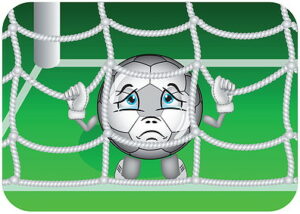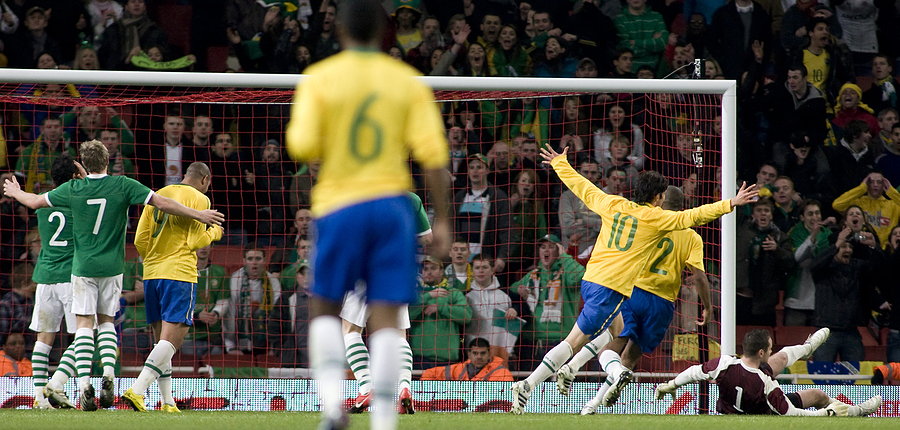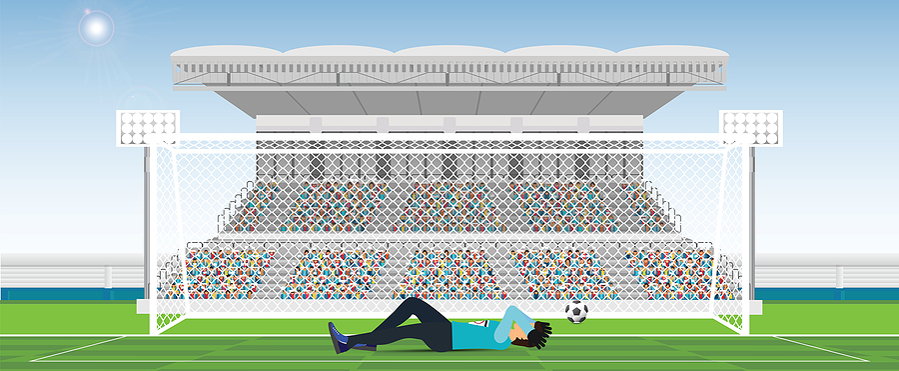 Arguably one of the most humiliating things that can occur for a footballer, scoring an own goal is seen as a big blunder and can often result in the player who did it, being subjected to abuse and ridicule from their own and opposition fans alike, or even being taken off for someone else.
Arguably one of the most humiliating things that can occur for a footballer, scoring an own goal is seen as a big blunder and can often result in the player who did it, being subjected to abuse and ridicule from their own and opposition fans alike, or even being taken off for someone else.
An own goal is essentially defined as an act from a player which results in the ball going into the goal that they are defending and as such, gives their opposition an advantage. Over the years, there have been some impressive own goals and they have actually become more commonplace, especially because of a certain number of factors which have caused these.
Own goals are important in betting as they can impact score and goalscorer bets as well as change results. There are different rules about how own goals count in various bet types, such as first/last goalscorer and correct score, which you can also read about on this page.
Reasons For Own Goals & Why They Are Increasing

There is not necessarily a definitive answer for what causes own goals and, like most things in football, there are multitude of different reasons. One of these could be attributed to weather conditions and most own goals that are caused due to for example, wet weather often directly come from a goalkeeper.
This is because attacking teams will look to take advantage of a wet surface or even a wet ball and usually employ the tactic of shooting from distance, hoping to catch the opposing goalkeeper off-guard. In these circumstances, if the ball is fired in low and hard, it is likely to skim off the surface, come off the keeper, or even spill out their hands and into the goal. This can even be the same case for a cross or a shot that is taken at chest height for example; the same thing could occur. Because the ball is wet, it can be the case that the goalkeeper will drop the ball into the goal. There have been many instances over the years where adverse weather conditions have caused own goals and savvy managers and players will make sure that they take advantage of this in the best way.
Another reason that is also quite common is where the ball may take a bad deflection which causes it to considerably change the course of its path and even trajectory. Again, in some cases, this is a tactic that some teams adopt deliberately. In this case, it often occurs if the defending team is sitting deep and has a lot of their own players in the penalty area. Here, the attacking team will either cross or shoot low and hard, knowing that there is a good chance of the ball taking a deflection and should this be the case, the ball could go anywhere – worse case scenario, it will result in them being awarded a corner kick. Many own goals have been conceded in this way over the years, with teams realising that this is a great way to try and gain an advantage.
Set-pieces have also been a considerable cause of own goals, with many players taking advantage from either corner kicks or free kicks and on some occasions, even throw-ins (Stoke City circa 2011 with Rory Delap’s iconic long throw which often caused havoc). From corners and free kicks in particular though, own goals often occur from the defensive player heading the ball into their own goal and their goalkeeper being caught completely unaware. This kind of own goal is perhaps the most common, because the defender (under pressure from attacking players), will misjudge the flight of the ball and catch it with the wrong part of their head.
Another reason could simply be down to footballing reasons. Over the years, styles of football have changed considerably, with some teams adopting a possession-based, pass and move philosophy (such as Barcelona, Pep Guardiola era) and as such, complex patterns of play would be adopted, designed to drag opposing players out of position, leaving them so disorientated that they could not do anything about scoring an own goal – especially they had stuck out their foot to try and block a shot.
Other styles include the high pressing approach, which is designed to put opposition defenders and goalkeepers under pressure and force them into making mistakes, such as passing back to their goalkeepers, but instead resulting in own goals. Liverpool (under Jurgen Klopp), employ this tactic very well. The rules of football today also favour attacking players much more so than in the past and this naturally means more shots that could result in an own goal.
Own Goals In The Premier League
| Season | Own Goals Scored | Percentage |
|---|---|---|
| 17/18 | 30 | 7.9 |
| 18/19 | 32 | 8.4 |
| 19/20 | 32 | 8.4 |
| 20/21 | 38 | 10 |
| 21/22 | 33 | 8.6 |
| Average | 33 | 8.68% |
If we take a look at the number and percentage of own goals which have been scored in the Premier League over five seasons (that’s based on 380 games in a PL season), we can get a more accurate illustration of how likely own goals are to occur in future football matches.
This assumes only 1 own goal was scored per game, of course.
If we look at the own goals scored over those five seasons and combine the percentages and ratio based on all of the games played, we can ascertain that there is an 8.68 percent chance of an own goal being scored in any Premier League fixture.
What Players Score The Most Own Goals

Because of the fact that strikers and in most cases, the majority of the midfield are usually positioned outside of the area, in open play most own goals usually come from defenders or goalkeepers, however, there are exceptions. In some cases, midfielders have been to blame in open play, when they have defied logic and decided to play the ball back to their goalkeeper, but misjudged the wind for example, or didn’t realise how far off the line their goalkeeper was.
From set pieces though, anything can happen and, quite often defending teams may use one of their attacking players, such as a centre forward to form part of the defence if they are tall and physical. Over the years, this has resulted in a number of own goals being scored by strikers. While Peter Crouch was more effective in his opposition’s penalty area, there was an instant in May 2011 against Manchester City when the Tottenham man turned a cross past his own goalkeeper.
Again though, the most common types of own goals have been the result of difficult set pieces, with defenders at fault for misjudging the flight of the ball. Arsenal in particular, over the years have been one of the teams who have conceded a lot of own goals from set pieces. In fact, according to worldfootball.net esteemed defender Tony Adams has three to his name, while in more recent times Kolo Toure, Thomas Vermealen and Laurent Koscielny have scored two own goals for the Gunners, with goalkeeper Manuel Almunia also racking up two in an era when Arsenal were not exactly known for their defensive ability.
Interestingly though, Manchester United feature quite prominently in recent times when it comes to own goals and the statistics do support the theory that defenders are the position that own goals commonly originate. Taking into account the last decade, each of Wes Brown, John O’Shea and Phil Jones have scored three own goals, while collectively over roughly a similar period of time, Victor Lindelof, Jonny Evans and Chris Smalling each scored two own goals for the Red Devils. Interestingly all-time record goalscorer Wayne Rooney, registered an own goal for the club he joined as a teenager. Perhaps as testament to his ability and what can be considered a rare accomplishment in the modern day, Champions League winning goalkeeper Peter Schmeichel did not score a single own goal while at the club.
When looking at the records for the most own goals scored, this certainly has some interesting reading. In fact, since the start of the Premier League, the top 10 of own goal scorers are all defenders, with Richard Dunne (Aston Villa, QPR and Manchester City) racking up a total of 10 own goals over his career.
Tied in second place with seven apiece are Jamie Carragher (Liverpool), Phil Jagielka (Sheff Utd, Everton, Stoke) and Martin Skrtel (Liverpool). You can see a few more top own goal scorers in the chart below.
| Player | Club(s) | Own Goals |
|---|---|---|
| Richard Dunne | Man City, Aston Villa | 10 |
| Jamie Carragher | Liverpool | 7 |
| Phil Jagielka | Sheffield United, Everton, Stoke | 7 |
| Martin Skrtel | Liverpool | 7 |
| Wes Brown | Manchester United, Sunderland | 6 |
| Lewis Dunk | Brighton | 6 |
| Johnny Evans | Man Utd, West Brom, Leicester | 6 |
| Ryan Shawcross | Stoke | 6 |
| Frank Sinclair | Chelsea, Leicester City | 6 |
There are too many with 5 own goals to their name to list, but Rio Ferdinand, Michael Duberry, Phil Neville, Neil Ruddock, and Henning Berg are all listed among the notable alumni of defenders.
While this table clearly indicates that defenders are one of the main positions responsible for own goals in the Premier League since it began, let’s take a more detailed look at own goals by position over a five season period, to see if those stats more accurately support this data.
| Season | Goalkeeper | Defender | Midfielder | Striker |
|---|---|---|---|---|
| 17/18 | 4 | 23 | 1 | 2 |
| 18/19 | 0 | 24 | 6 | 2 |
| 19/20 | 4 | 20 | 6 | 2 |
| 20/21 | 3 | 26 | 6 | 3 |
| 21/22 | 4 | 25 | 4 | 2 |
| Average | 3 | 23.6 | 4.6 | 2.2 |
This does, without a doubt support the fact that defenders are the most often responsible for own goals and in fact were accountable for 70.65% of them over the campaigns studied. Accounting for the 8.98% scored by a keeper, that means 20.35% percent of own goals scored during these seasons were courtesy of midfielders and strikers.
Betting On Own goals
 Over the last decade, bookmakers have seen more and more value in offering an own goal market and some even give players the opportunity to pick individual scorers of own goals and this can be especially popular if customers can identify a player who could well be at risk. In football betting, staking on an own goal can be seen as an effective hedging strategy, particularly if you have a number of bets with different permutations such as ‘Both Teams To Score’ or ‘x team to score first’. Instead of just deciding to take a punt on this market though, it is recommended that you do your research to see if a team could be at risk, based on their history.
Over the last decade, bookmakers have seen more and more value in offering an own goal market and some even give players the opportunity to pick individual scorers of own goals and this can be especially popular if customers can identify a player who could well be at risk. In football betting, staking on an own goal can be seen as an effective hedging strategy, particularly if you have a number of bets with different permutations such as ‘Both Teams To Score’ or ‘x team to score first’. Instead of just deciding to take a punt on this market though, it is recommended that you do your research to see if a team could be at risk, based on their history.
Or in fact, there could be some dangerous set piece takers on one team who have an ability to cause mayhem in the opposition area with their deliveries. This was especially the case in the mid 2000s and the first ‘Galactico’ era Real Madrid who had David Beckham, Roberto Carlos, Zinedine Zidane, Luis Figo, Guti, Raul and Ronaldo (the Brazilian) all capable of taking a very effective set piece and quite often, they would rotate in a match to keep their opposition on their toes.
What you bet on is also an important consideration. One little known fact, for example, is if you bet on goalscorer markets then own goals are excluded. Within goalscorer markets there is often a line for ‘no goalscorer’, you might think this is the same as betting on a ‘0-0 correct score’, but it isn’t. If a game finishes 1-0 and the only goal was an own goal then the no goalscorer market will pay out but the 0-0 correct score bet will not.
There are some bookies out there that occasionally offer own goal insurance on bets. When you consider the chance of an own goal in a match is around 8-9% on average then these can be valuable offers, especially if an own goal leads to a winning bet going down.
Final Thoughts
Own goals in football can be and indeed have been, the subject of quite a lot of entertainment with some having a substantial amount of comedy value associated with them. As the game of football has progressed over the years, particularly becoming faster and more technical, own goals have had a tendency to become much more commonplace, while the ball has also had a lot to do with it.
The material of balls has had a detrimental effect on a player’s ability to judge the flight of them over the years, with different forms of leather used which has resulted in the ball moving differently in mid air. Whether this will continue to be a common factor remains to be seen, however, even in the game of football, technology has started to creep into the game over the last couple of years.